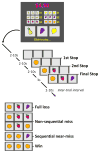Altered neural correlates of reward and loss processing during simulated slot-machine fMRI in pathological gambling and cocaine dependence
- PMID: 25448081
- PMCID: PMC4266109
- DOI: 10.1016/j.drugalcdep.2014.09.013
Altered neural correlates of reward and loss processing during simulated slot-machine fMRI in pathological gambling and cocaine dependence
Abstract
Background: Individuals with gambling or substance-use disorders exhibit similar functional alterations in reward circuitry suggestive of a shared underlying vulnerability in addictive disorders. Additional research into common and unique alterations in reward-processing in substance-related and non-substance-related addictions may identify neural factors that could be targeted in treatment development for these disorders.
Methods: To investigate contextual reward-processing in pathological gambling, a slot-machine fMRI task was performed by three groups (with pathological gambling, cocaine dependence and neither disorder; N = 24 each) to determine the extent to which two groups with addictions (non-substance-related and substance-related) showed similarities and differences with respect to each other and a non-addicted group during anticipatory periods and following the delivery of winning, losing and 'near-miss' outcomes.
Results: Individuals with pathological gambling or cocaine dependence compared to those with neither disorder exhibited exaggerated anticipatory activity in mesolimbic and ventrocortical regions, with pathological-gambling participants displaying greater positive possible-reward anticipation and cocaine-dependent participants displaying more negative certain-loss anticipation. Neither clinical sample exhibited medial frontal or striatal responses that were observed following near-miss outcomes in healthy comparison participants.
Conclusions: Alterations in anticipatory processing may be sensitive to the valence of rewards and content-disorder-specific. Common and unique findings in pathological gambling and cocaine dependence with respect to anticipatory reward and near-miss loss processing suggest shared and unique elements that might be targeted through behavioral or pharmacological interventions in the treatment of addictions.
Keywords: Addiction; Cocaine dependence; Near-miss; Pathological gambling; fMRI.
Copyright © 2014 Elsevier Ireland Ltd. All rights reserved.
Conflict of interest statement
Figures





Similar articles
-
Alterations in functional brain networks associated with loss-chasing in gambling disorder and cocaine-use disorder.Drug Alcohol Depend. 2017 Sep 1;178:363-371. doi: 10.1016/j.drugalcdep.2017.05.025. Epub 2017 Jun 28. Drug Alcohol Depend. 2017. PMID: 28697386 Free PMC article.
-
Disruption of Reward Processing in Addiction : An Image-Based Meta-analysis of Functional Magnetic Resonance Imaging Studies.JAMA Psychiatry. 2017 Apr 1;74(4):387-398. doi: 10.1001/jamapsychiatry.2016.3084. JAMA Psychiatry. 2017. PMID: 28146248
-
Pathological gambling and alcohol dependence: neural disturbances in reward and loss avoidance processing.Addict Biol. 2015 May;20(3):557-69. doi: 10.1111/adb.12144. Epub 2014 Apr 22. Addict Biol. 2015. PMID: 24754423
-
The anticipatory dopamine response in addiction: A common neurobiological underpinning of gambling disorder and substance use disorder?Prog Neuropsychopharmacol Biol Psychiatry. 2020 Mar 2;98:109802. doi: 10.1016/j.pnpbp.2019.109802. Epub 2019 Nov 1. Prog Neuropsychopharmacol Biol Psychiatry. 2020. PMID: 31678482 Review.
-
Disordered gambling: the evolving concept of behavioral addiction.Ann N Y Acad Sci. 2014 Oct;1327(1):46-61. doi: 10.1111/nyas.12558. Ann N Y Acad Sci. 2014. PMID: 25336388 Free PMC article. Review.
Cited by
-
Clinical neuropsychiatric considerations regarding nonsubstance or behavioral addictions.Dialogues Clin Neurosci. 2017 Sep;19(3):281-291. doi: 10.31887/DCNS.2017.19.3/mpotenza. Dialogues Clin Neurosci. 2017. PMID: 29302225 Free PMC article. Review.
-
The neural vulnerabilities in reward processing in gambling disorder.J Behav Addict. 2025 Jun 23;14(2):1010-1020. doi: 10.1556/2006.2025.00049. Print 2025 Jul 2. J Behav Addict. 2025. PMID: 40549966 Free PMC article.
-
Gender Differences in Gambling Disorder: Results from an Italian Multicentric Study.Clin Neuropsychiatry. 2024 Aug;21(4):313-322. doi: 10.36131/cnfioritieditore20240407. Clin Neuropsychiatry. 2024. PMID: 39309026 Free PMC article.
-
Amplified Striatal Responses to Near-Miss Outcomes in Pathological Gamblers.Neuropsychopharmacology. 2016 Sep;41(10):2614-23. doi: 10.1038/npp.2016.43. Epub 2016 Mar 23. Neuropsychopharmacology. 2016. PMID: 27006113 Free PMC article. Clinical Trial.
-
Gender-related differences in neural responses to gaming cues before and after gaming: implications for gender-specific vulnerabilities to Internet gaming disorder.Soc Cogn Affect Neurosci. 2018 Nov 8;13(11):1203-1214. doi: 10.1093/scan/nsy084. Soc Cogn Affect Neurosci. 2018. PMID: 30272247 Free PMC article.
References
-
- Beck AT, Steer RA, Ball R, Ranieri WF. Comparison of Beck Depression Inventories-IA and-II in psychiatric outpatients. J Person Assess. 1996;67:588–597. - PubMed
-
- Billieux J, Van der Linden M, Khazaal Y, Zullino D, Clark L. Trait gambling cognitions predict near-miss experiences and persistence in laboratory slot machine gambling. Br J Psychol. 2012;103:412–427. - PubMed
-
- Brown GG, Mathalon DH, Stern H, Ford J, Mueller B, Greve DN, McCarthy G, Voyvodic J, Glover G, Diaz M, Yetter E, Ozyurt IB, Jorgensen KW, Wible CG, Turner JA, Thompson WK, Potkin SG Function Biomedical Informatics Research N. Multisite reliability of cognitive BOLD data. NeuroImage. 2011;54:2163–2175. - PMC - PubMed
Publication types
MeSH terms
Grants and funding
LinkOut - more resources
Full Text Sources
Other Literature Sources
Medical

